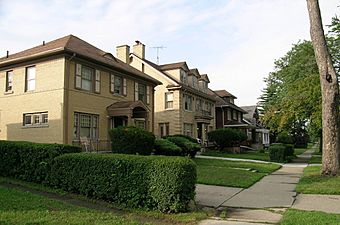Medbury's–Grove Lawn Subdivisions Historic District facts for kids
Quick facts for kids |
|
|
Medbury's–Grove Lawn Subdivisions Historic District
|
|

Streetscape on Puritan near Woodward
|
|
| Location | Highland Park, Michigan |
|---|---|
| Architect | Leonard B. Willeke |
| Architectural style | Colonial Revival, Bungalow/Craftsman, Tudor Revival |
| NRHP reference No. | 88000049 |
| Added to NRHP | February 8, 1988 |
The Medbury's–Grove Lawn Subdivisions Historic District is a special neighborhood in Highland Park, Michigan. It is called a historic district because its buildings and area are important to history. This district includes three streets: Eason Street, Moss Street, and Puritan Street. It stretches from Hamilton Avenue to Woodward Avenue. In 1988, this area was added to the National Register of Historic Places. This means it is officially recognized for its historical value.
Why This Area Is Historic
Before the 1900s, Highland Park was mostly farmland. But around 1900, big factories started to open nearby. Companies like Ford and Chrysler built large plants. This brought many new jobs to the area.
Because of these jobs, more and more people moved to Highland Park. The population grew very quickly. Between 1900 and 1910, the number of people increased ten times! It grew from 427 to 4,120. By 1920, it had grown ten times again, to 46,499 people.
As more people arrived, new places to live were needed. The Medbury's and Grove Lawn areas were planned out for homes between 1904 and 1914. Most of the houses in these areas were built between 1914 and 1924. Some building continued until about 1934.
What the District Looks Like
The Medbury's–Grove Lawn Subdivisions Historic District is a neighborhood with many single-family homes. There are 272 homes in the district. About 251 of these homes are considered "contributing." This means they still look like they did when the neighborhood was first built. These homes help show the district's history.
Most of the houses were built in the 1910s and 1920s. They show off many popular building styles from that time. You will see many Bungalow-style houses. These often have Craftsman or colonial details. In fact, this neighborhood has one of the best collections of bungalows in Michigan!
You can also find other styles of homes here. These include foursquare homes, colonial revival homes, and English cottage homes. The houses in this district are special because they are all different. They also show great skill in how they were built. They are excellent examples of how American homes looked between 1900 and 1930.
The district also has 272 garages and sheds. These are usually found behind the homes, along small alleys. About 250 of these garages and sheds are from the original time the neighborhood was built. They show that many middle-class families lived here.
Images for kids






